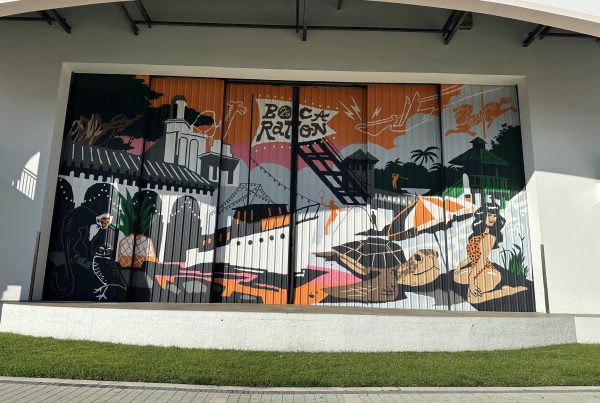“We’ve lost sight of the bear.”
The voice came through the walkie-talkie of a member of the expedition team with a polite urgency. A thick fog had rolled in, and one of the polar bears that the scouts had been observing since morning disappeared in the haze. It was time to move.
It was the first time the passengers of Le Commandant Charcot had set foot off the ship in days on a polar expedition that had been thwarted by poor weather and impenetrable ice at nearly every turn. Cabin fever had set in, and there was a growing concern amongst the passengers that we may never leave the ship. But that morning, we found an accommodating stretch of ice that brought us closer to the coast of Greenland than we had been the entire voyage. Upon stepping off the ship onto a sheet of solid ice, a fellow passenger remarked in a heavy French accent, “Greenland at last.”
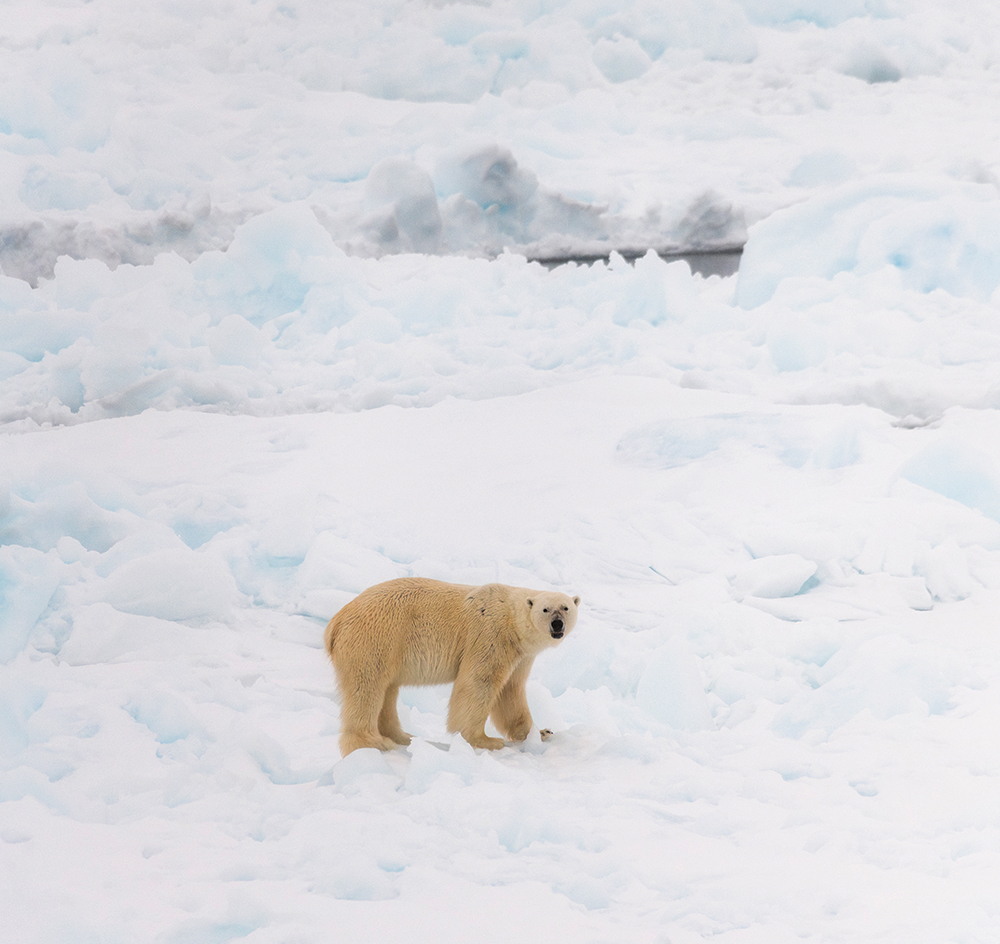
Welcome Aboard
The 11-day voyage of Le Commandant Charcot began in Reykjavik, Iceland. Upon embarkation we were received warmly by the ship staff, who offered welcome drinks, dispensed room keys, and confirmed food allergies and other details that would inform the highly tailored service throughout the cruise.
We then settled into our room, an elegant cabin, cozy but spacious enough for two, with two bright orange parkas laying pressed on the bed. These hefty coats would make us easier to spot during expeditions and keep us warm through the brisk Nordic spring, where temperatures typically hover around the mid-20s. Outside, a gentle snow was falling and clung to the railing of our private balcony. Through the glass sliding doors we learned to appreciate an Icelandic term that we had picked up along the way: “gluggaveður,” meaning window weather, or a climate that’s best admired from indoors.
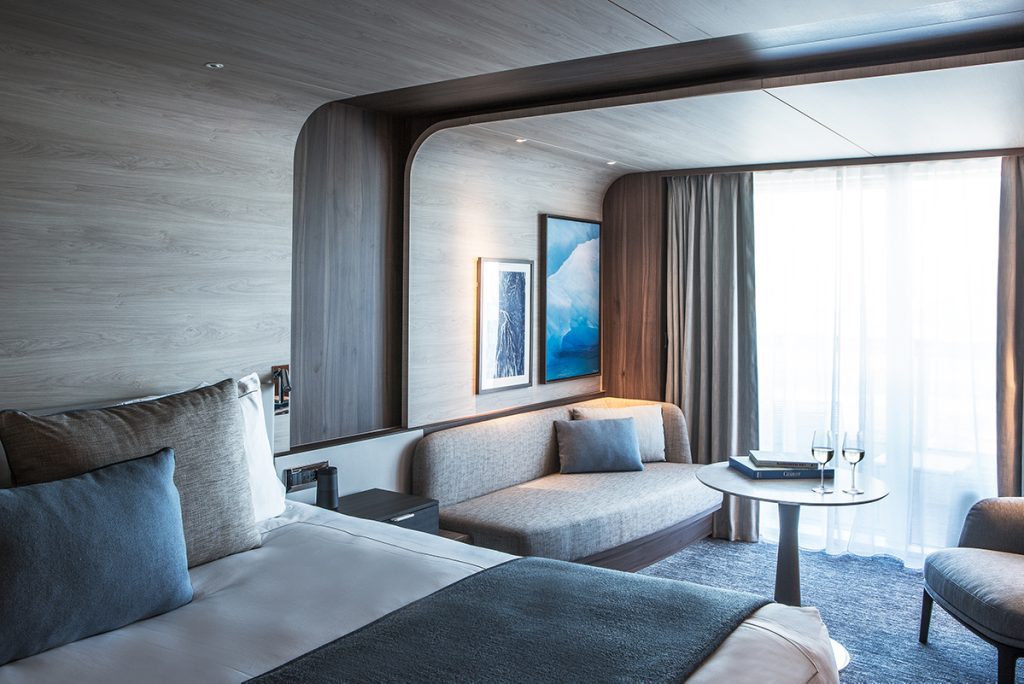
On our first night, we were invited to the ship’s theater, where we were officially welcomed onboard by Captain Étienne Garcia, who explained what we could expect during our voyage and shared information about the Charcot.
Developed by French cruise line Ponant, Le Commandant Charcot is the only luxury icebreaking ship in the world. It’s rated as a Polar Class 2 vessel, meaning it can withstand and crash through ice of 10 feet or more—though the Charcot falls into the “more” camp, with the ability to churn through up to about 50 feet of ice through the use of dual propellers on the ship’s aft. These propellers are the workhorses when the ice gets too thick to break with the 6-centimeter hull of the ship’s bow (a typical cruise ship’s hull is only about 1 centimeter).
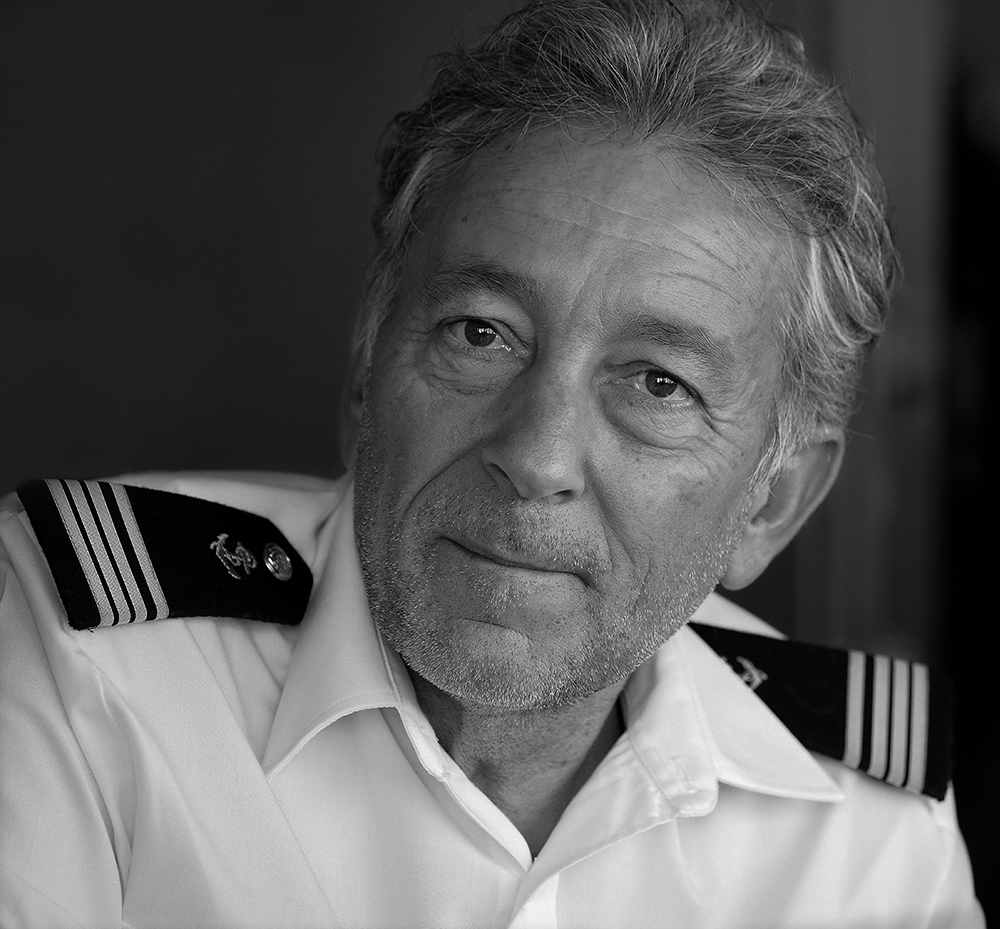
Garcia, who is French, gave his introduction in both French and English, and immediately endeared himself to passengers. He was at ease and charismatic, dispensing wit and wisdom alike as he explained the nature of the expedition.
“I didn’t decide yet where to go,” the captain once said, to which some of the crowd laughed, not realizing it wasn’t fully a joke. The ice of the region where we were headed changes yearly, so every expedition is different depending on the conditions—with the Charcot even providing detailed ice maps for other vessels to use as reference for safe passage. Garcia summed it up best when he said, “The ice will decide.”
Charting a Course
The course of Ponant’s “Inuit Spring of Ammassalik” expedition would take us first to Tasiilaq, a town of 2,000 that is the largest outpost in eastern Greenland. We set course on our first night, and by the following afternoon the dark, choppy waters of the Denmark Strait calmed and turned a deep blue, and soon the sea disappeared entirely—giving way to solid ice that extended endlessly in every direction.
Though we were briefed on the Charcot’s capabilities from the cruise literature and the captain and crew, learning about it and experiencing it are two very different things.
As we moved deeper into this world of ice, the Charcot would lurch and shudder as it crushed through the thick sheets. Ice stretched on either side for as far as we could see, and the only water visible was in our wake, where vast chunks of ice dozens of feet thick would crack and drift away. The raw power and ingenuity at work was staggering to behold as the ship carved its way through impossible terrain so unfamiliar that it might as well be on a different planet.
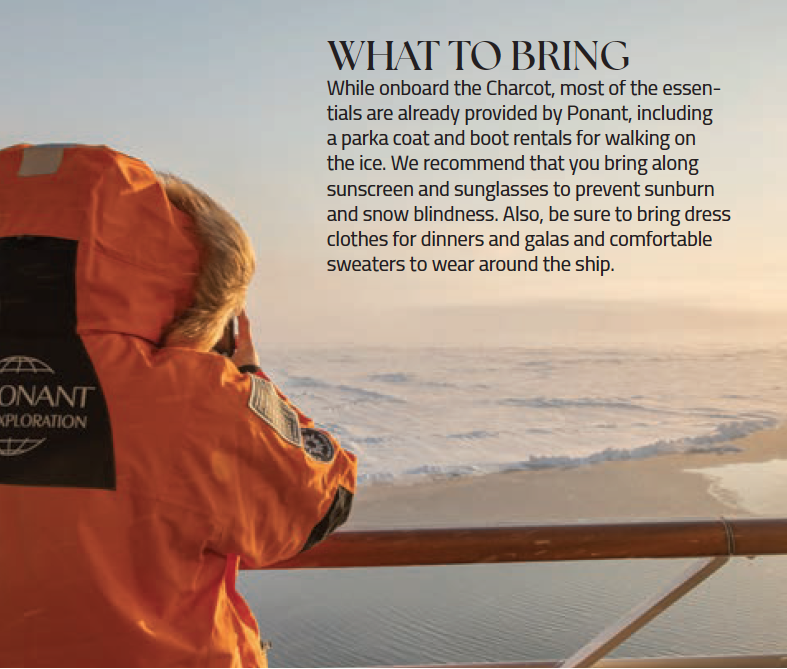
We soon became accustomed to the shaking of the ship and the rattling of glasses on the table of our room. Every now and then we would run into a particularly troublesome patch of ice that would result in a thunderous clunk, but the ship was well-equipped for the shock—the collisions were never disruptive and not once threw us off balance or caused discomfort.
From our departure point in Reykjavik, we were 500 miles from Tasiilaq, the last roughly 100 of which would be almost entirely ice. After visiting Tasiilaq, the plan was to hop around the fjords of the Ammassalik and Blosseville regions off Greenland’s coast. Along the way, expeditions would be led for dog sledding, kayaking, and a guided, two-day, one-night polar trek where the adventurous among us would camp in the frigid, barren wilderness.
But the ice had other plans.
Life Onboard
On our first full day at sea, we quickly and comfortably settled into life onboard the Charcot. With a max occupancy limit of 245 guests across its 123 staterooms and suites, we were never left wanting for breathing room and were always able to find a cozy spot to share with ourselves on either of the two main common-area decks on levels five and nine.
These decks are home to the Charcot’s two restaurants which, like other areas of the ship, take their names from the Inuit language—Nuna meaning “earth” and Sila meaning “sky.” Nuna is the see-and-be-seen restaurant, where diners were expected to dress to impress and where the luxurious welcome and farewell galas were held. Here diners could enjoy French and international cuisine in a swanky, fine-dining setting, complete with two sommeliers to suggest pairings for each course of the meal.
Though we were consistently impressed with the a la carte offerings at Nuna, we more often opted for Sila for the atmosphere. This more casual, buffet-style restaurant boasted breathtaking views of the frozen sea and distant mountains of Greenland through wall-to-wall, floor-to-ceiling windows—prime gluggaveður.
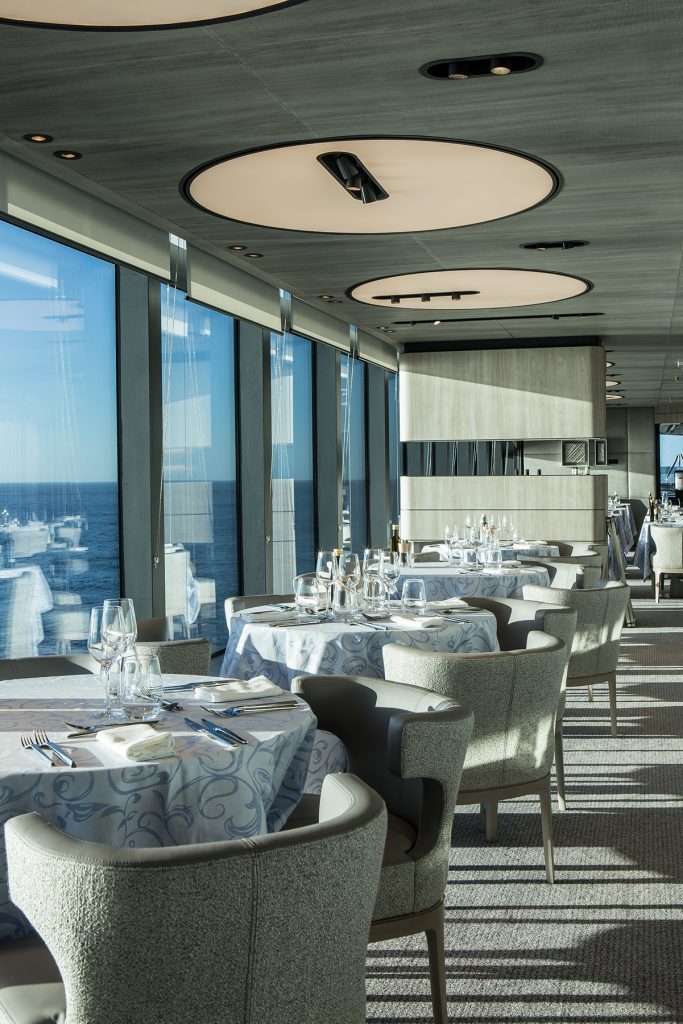
Decks five and nine are also the entertainment hubs of the Charcot. At the deck five bow is the theater, or Kita (Inuit for “let’s go”), which hosted our daily briefings for updates on our voyage, nightly performances, and daily lectures from scientists brought on by Ponant to educate passengers about the region. Outside the theater is a bar and lounge area, where daily tea times would be hosted featuring a delectable assortment of pastries, teas and hors d’oeuvres.
Moving up to deck nine, passengers could take in panoramic Arctic views over a cocktail at the observation lounge, Anori (Inuit for “the wind”). We often found ourselves here, as did many passengers, who—like us—never failed to be struck by the frozen world we were carving our way through.
Deck nine is also the place to be for all of your zen needs, which can be met at the spa, Nuan (Inuit for “wellness / happiness”). Those looking for a hot spring experience can visit the heated pool on deck nine, which wraps around the ship’s aft and is kept between 80 and 98 degrees—just have your robe ready when you get out, and that Arctic breeze hits.
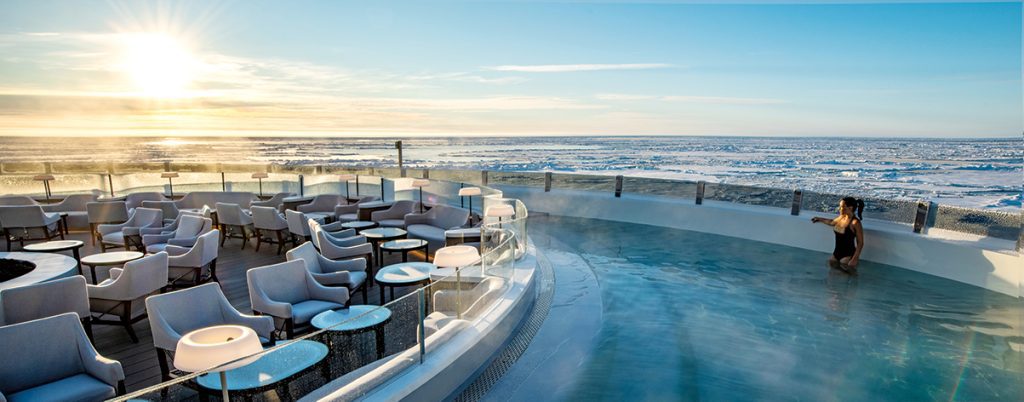
Back down at the Kita, we enjoyed elaborate and stunning opera and dance productions, explored Inuit culture during a lecture from a Tasiilaq native, and learned the various ways in which this cold, hard world of ice betrayed a deeper fragility—with more and more ecosystems melting away each year from climate change.
Sustainability and exploration are the dual philosophies that informed the Charcot’s creation and its many expeditions to the north and south polar regions, the latter of which the ship’s namesake, explorer Jean-Baptiste Charcot, led the first French Antarctic expedition. To reduce the carbon footprint of travel, the ship is powered by liquefied natural gas and contains no single-use plastics onboard.
In keeping with the theme of exploration, the Charcot also has a wet and dry science lab, utilized by a rotating team of scientific experts from a variety of fields. While it has all the trappings of a luxury cruise vessel, the Charcot places a deep emphasis on scientific discovery through its partnership with the world-famous Explorers Club, of which several of the onboard speakers were members. The appeal for scientists is as clear as the appeal for passengers—the Charcot opens up a part of the world for study that would otherwise be inaccessible.
The Voyage
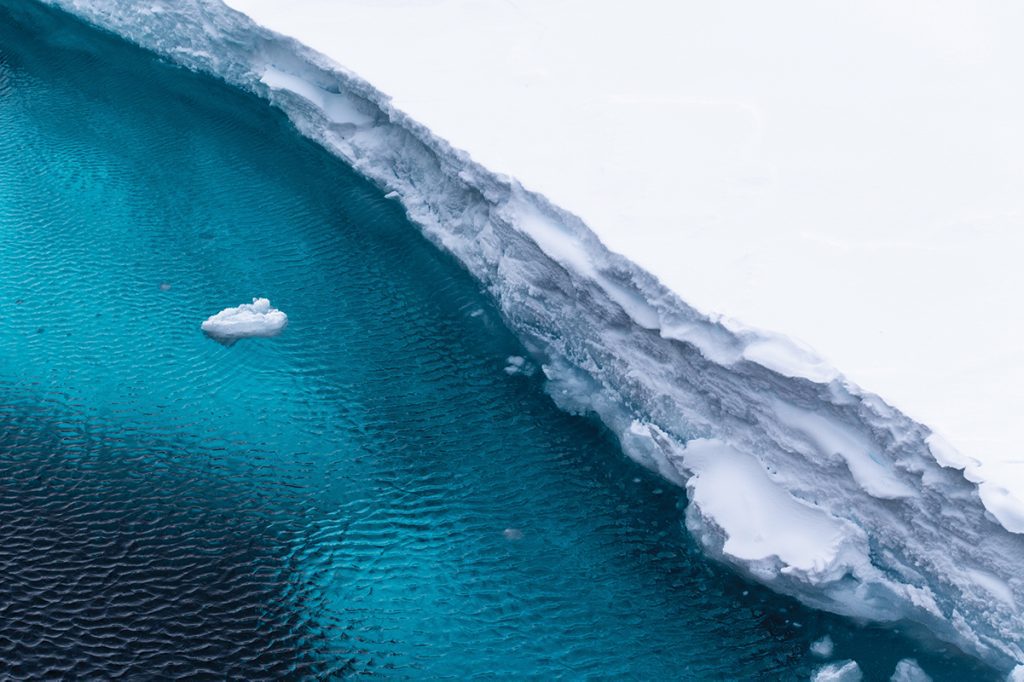
While en route to Tasiilaq, we passed through a stretch of calm seas which we were able to take advantage of with a zodiac expedition through the glassy blue waters of the Denmark Strait, right up to a patch of small icebergs. A trick of the light caused the ice to glow a bright, mystical blue beneath the surface, and it seemed to “breathe” up and down with the ocean swell. Here we were reminded of something Garcia had said in one of our daily briefings, that “the ice is alive.”
Part of the challenge of polar navigation is that the ice is never the same from year to year. The way Garcia talked about it, it was as though the ice had a mind and will of its own. A clear path to the coast one year might be blocked by ice the next—as we soon found out.
A storm system near Tasiilaq forced us south looking for fast ice—ice that is “fastened” to the coast and therefore more stable—where we could disembark for further expeditions. We moved down the coast of Odinland, a barren, austere wilderness of rugged mountains that drifted along our starboard side. It was another day at sea, which the passengers took in stride by relaxing at the observation lounge and attending lectures on photography and a year in the life of a polar bear—the former of which was a boon to the many onboard, like myself, who brought with them fancy cameras they didn’t know how to use.
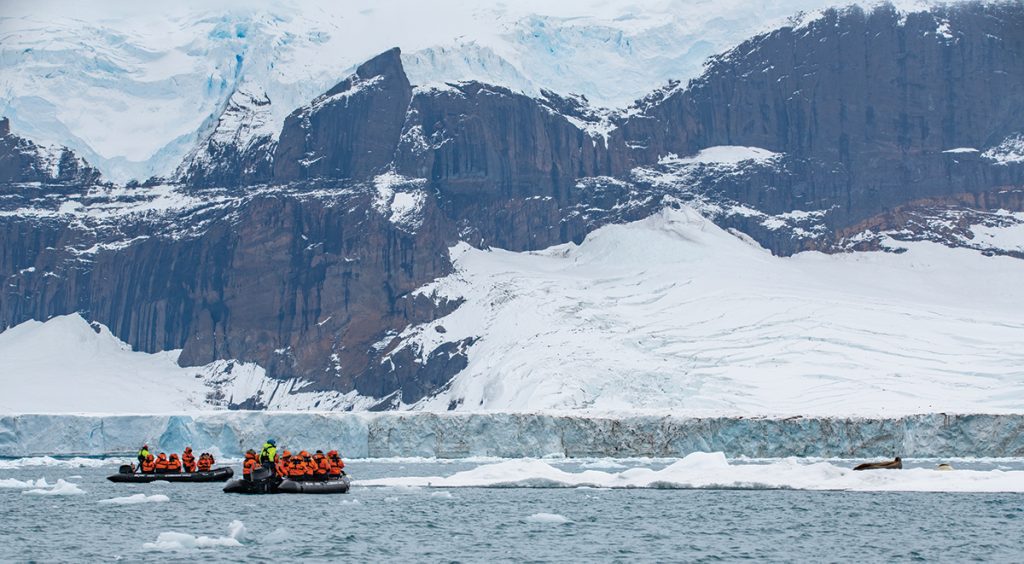
The following few days were filled with a mounting restlessness as our advances toward the Greenland coast were continuously rebuffed. It was a game of inches as the Charcot crashed through the ice, slowly plowing through until finally hitting an impenetrable sheet. At this point, the two 18-foot propellers on the ship’s aft would then be used to grind the ice behind us, “making slushies,” as Garcia said, taking us back the way we came.
With nowhere to safely anchor, the days passed without any of the planned excursions taking place. The tensions came to a head at one particular daily briefing where Garcia fielded questions.
Many of the passengers were French, with some from across Europe and a few Americans, so questions asked in French were translated to English as a common denominator—though the tones of the questions needed no translation. Passengers wanted to know if perhaps the trip had been scheduled too early; Ponant’s Greenland cruises typically leave a few weeks later, in May. One passenger asked that we simply return to Iceland, a request that was met with widespread disapproval from the rest.
Garcia’s responses were measured and thoughtful, and he never once seemed disarmed by the questions. Would conditions have been better in May? Not necessarily, he said, it was just a year of thicker ice. The concern, he told us, is not getting in, but getting out. And if we got stuck, there weren’t many vessels in the world that could have gotten us unstuck.
“We are humble with nature,” said Garcia. “If we don’t go, it’s because it’s not safe to go.” Still, many in the crowd expressed their gratitude to Garcia for prioritizing the safety of the passengers. They commented on the incredible things that we had already seen and expressed hope for our remaining time onboard—hopes that were met the next day when we made our first steps on the ice.
It’s All Nice on Ice
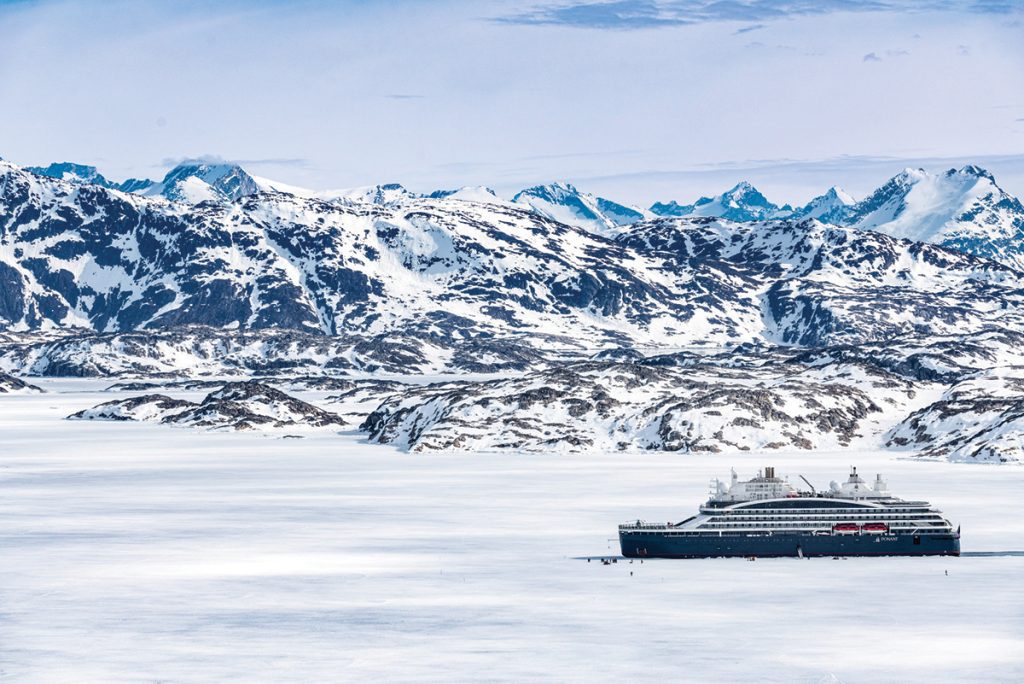
The ship had already stopped by the time we awoke the next morning. Outside our balcony, it looked as though the Charcot had been plucked from the sea and placed atop a vast landmass of ice.
The tracks of curious polar bears could be seen leading up to the ship then back off toward the snow-dusted mountains of the fjords beyond. The crew had been assessing the bears’ behavior for hours before we could disembark, and when we finally did, a collective tension seemed to break.
We stepped off the ship onto a frozen sheet of the Denmark Strait. Below our feet was roughly 3 feet of solid ice atop a murky, fathomless sea. A perimeter had been set up for the safety of the passengers, on the edge of which were sentries with flares and rifles who were glassing the bears that had been spotted. Before disembarking, we were told in the most uncompromising terms that we were to listen to every instruction from the expedition team so that we could avoid any unfortunate run-ins with a bear. Nobody protested.
Out on the ice, a group of passengers were cross-country skiing along the edge of the perimeter, guided by a crewmember. Further in the perimeter, a little girl was building a snow castle, a member of the onboard science team was at work boring a hole into the ice with an auger for fishing, and another of the scientists was building a snowman. Tables and inflatable chairs had been set up near the ship for a Champagne and caviar tasting, and passengers lined up at the bow to hold the anchor chain and pose for pictures.
It was late in the afternoon when the voice came over the radio and announced the ominous disappearance of one of the polar bears. By then the perimeter had already shrunk twice to accommodate the bears’ movements, and a flurry of snow began to fall. The mountains that had been so clear in the morning were now just vague, towering shapes fading in the haze of a beautiful, hostile world. The expedition team moved us back onboard, and soon the snow whited out the mountains entirely and covered our scattered footprints, erasing any trace that we were ever there.
That night, Garcia’s voice came through the ship’s announcement system that the Northern Lights could be spotted from the ship’s aft. Late though it was, dozens of passengers donned their orange parkas and made their way into the cold and marveled at the green ephemeral wisps that rose above the mountains, as delicate as chimney smoke.
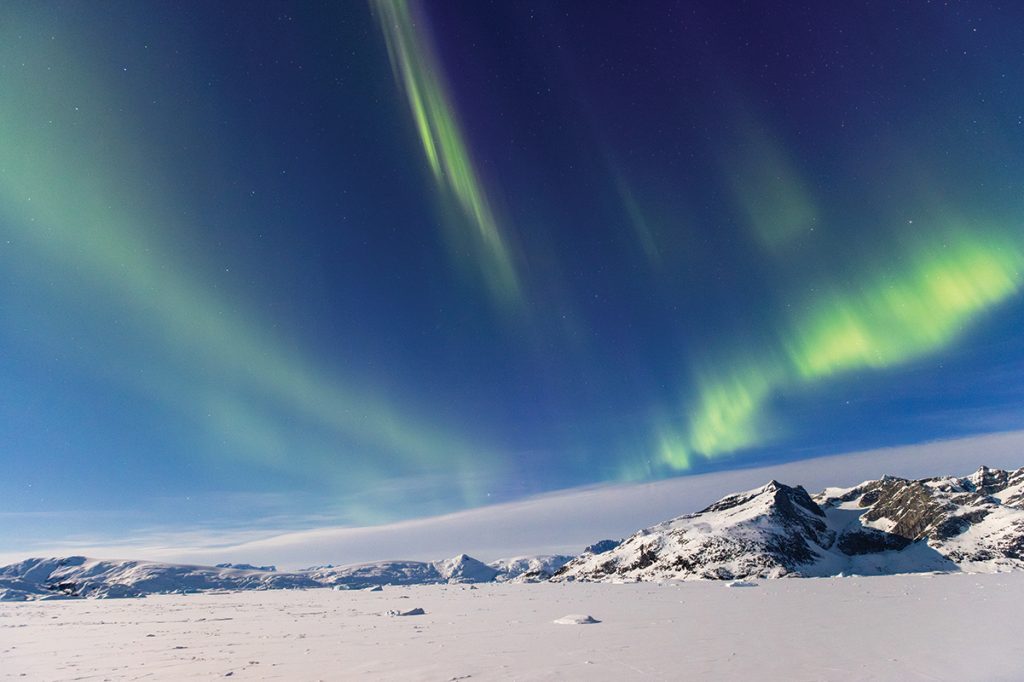
The Way Back
The spirits of the passengers—and crew—had been lifted considerably by the outing. Because the ice was constantly changing, we had to abandon our current spot and started the search for a new place to disembark for more time on the ice. One day, Captain Garcia’s voice came over the speakers announcing that theater performances and lectures would be canceled.
“This is, how you say, a work day for the Charcot,” he said. And it certainly was—the ship shuddered and shook from day to night as it crashed through layer upon layer of ice. Admirable though the attempts were, we were again and again rebuffed. But as more signs of wildlife began revealing themselves, the trip soon became a sort of Arctic safari.
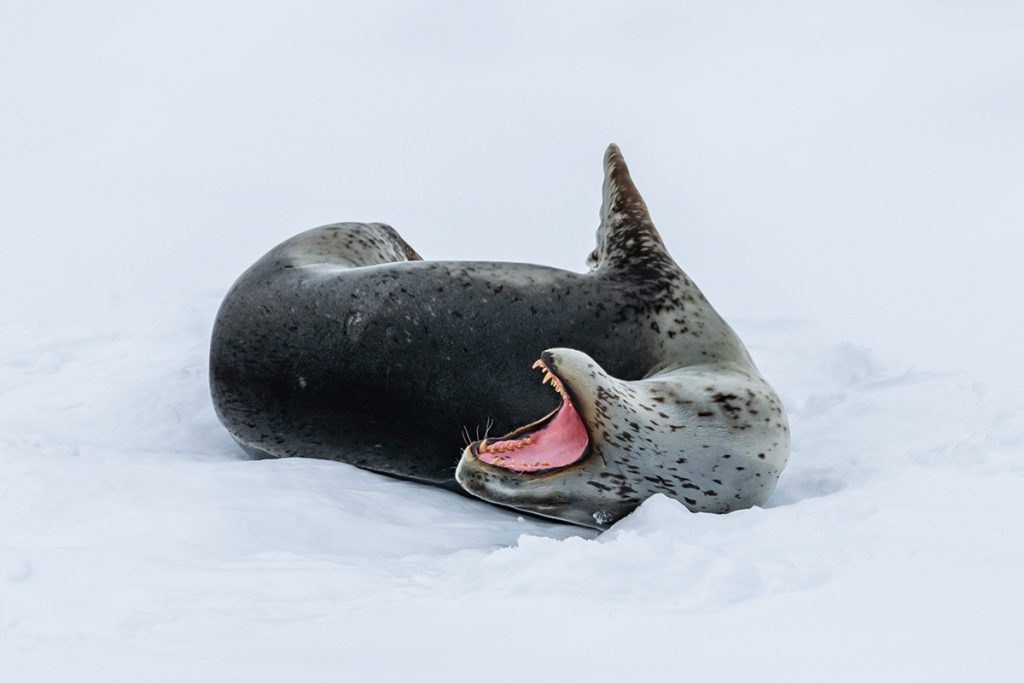
One foggy morning as we were cutting through ice, a polar bear was spotted a couple hundred yards beyond us. An announcement was made, and passengers made their way to the bow to watch as we followed after a lone polar bear roaming the ice that was no less than 50 miles from the coast. The bear seemed unperturbed, occasionally casting a backward glance at the great steel ghost haunting its trail as it looked for seals—a rare sign of life in an icy oblivion.
As we made our way out of the ice and into the choppy sea on our route back to Reykjavik, there were several more run-ins with polar bears, whales, seals and orcas, the novelty of which never faded. At one point a pod of playful orcas, seemingly aware of the eyes on them, leapt in and out of the water near the bow of the ship, putting on a show for the many onlookers. Elsewhere on our return, every breach of a group of bottlenose whales drew gasps and excited finger points from passengers.
When we arrived back to Reykjavik, the city looked as unfamiliar as our first encounter with the endless ice. We had grown accustomed to the frozen, barren wilderness to the point that the glow of lights and the bustle of civilization seemed otherworldly as the crimson sun set behind the rocky fjords of Iceland.
To learn more about Ponant and its cruise offerings, click here.
This story is from the November/December 2024 issue of Boca magazine. For more like this, click here to subscribe to the magazine.




